Study 1: 1% effect in 11 cities in the U.S.
In 1972 there were a number of cities in the U.S. where 1% of the population had learned the Transcendental Meditation technique. For 11 such cities another nearby city was chosen with comparable demographic variables (geographic location, population and student population) where TM had not yet been learned by 1%. These served as the control cities. Then crime statistics were requested from the FBI and compared.
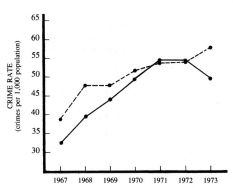 The statistics showed that in the 1% cities (full line) a significant decrease occurred in crime from 1972, both compared to earlier trends in the same city, and compared to the control cities (dotted line). There was a decrease in the number of crimes of 16.5% (p<.001). Compared to overall crime trends in the U.S. the decrease was even greater, 18%.
The statistics showed that in the 1% cities (full line) a significant decrease occurred in crime from 1972, both compared to earlier trends in the same city, and compared to the control cities (dotted line). There was a decrease in the number of crimes of 16.5% (p<.001). Compared to overall crime trends in the U.S. the decrease was even greater, 18%.
However, it turned out that this study wasn’t perfect, as a change in crime trends in the 11 cities with 1% TM practitioners could already be seen starting 1971 (crime stopped increasing in 1971 and starts decreasing from 1972).
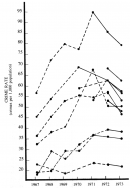 However, when you look at more detailed crime statistics for the 11 cities, you’ll find that in quite a few cities sufficient TM practitioners lived in the cities in 1971 already to make up 1% of the population (line full as soon as 1% threshold is reached). This meant that the average of the 11 cities no longer increased from 1971 to 1972. This therefore appears to be extra confirmation of the effect. As soon as the 1% threshold is reached, crime will decrease.
However, when you look at more detailed crime statistics for the 11 cities, you’ll find that in quite a few cities sufficient TM practitioners lived in the cities in 1971 already to make up 1% of the population (line full as soon as 1% threshold is reached). This meant that the average of the 11 cities no longer increased from 1971 to 1972. This therefore appears to be extra confirmation of the effect. As soon as the 1% threshold is reached, crime will decrease.
The full study is published in: Scientific Research on Maharishi’s Transcendetental Meditation Vol. 1, 98, pp 639-648
Study 2: Decrease in crime in Cleveland, U.S.
In four suburbs in Cleveland where 1% of the population had learned TM, a significant correlation between the number of TM practitioners and a decrease in the number of crimes during 3 consecutive periods was studied (1973-74 r = -.81, p<.001, 1975 r = -.42, p<.01 and the first half of 1976 r = -.78, p<.001).Ref.Scientific Research on Maharishi’s Transcendental Meditation, Collected Papers Vol. 2, 166. pp. 1199-1204
Study 3: Crime decrease in 24 cities across the U.S.
This study is a follow up study from study 1, the earlier study where in 11 cities where 1% of the population had learned the TM technique a decrease in crime was noticed of 16.5% as compared to control cities. This study is an expansion of the original study in several areas: more cities (24 instead of 11), better monitoring of other possible variables that could explain the effect, and the effect seen over a longer time period (5 years instead of 1 year).
Other possible explanations for crime decrease were studied and ruled out in this study (because they were comparable to control cities). The control cities were also selected by an independent scientist, so that there could be no case of sub-conscious influencing of the result through the choosing of specific control cities.
- Average level of education
- Percentage in the same residential area after 5 years
- Unemployment rate
- Percentage in age group 15-29 years
- Percentage under poverty line
- Population density
- Per capita income.
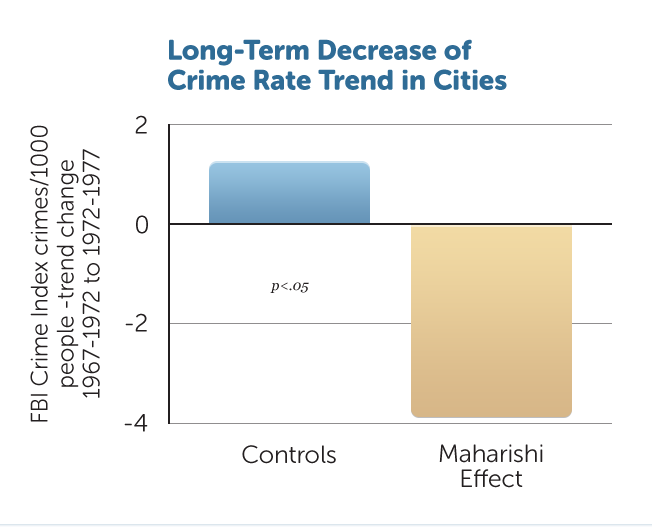 This more detailed study demonstrated that the effect that could be attributed to the TM practitioners was greater than in the earlier study (study 1). It was calculated that the TM practitioners had created a 22% decrease of crime (p<.001). In the longer term as well, over a period of 5 years, the control cities saw a faster increase in crime than predicted against earlier trends, while the 1% cities demonstrated a consistent decrease in crime as compared to earlier trends.Ref.Journal of Crime and Justice vol. 4, 1981, pp 25-45
This more detailed study demonstrated that the effect that could be attributed to the TM practitioners was greater than in the earlier study (study 1). It was calculated that the TM practitioners had created a 22% decrease of crime (p<.001). In the longer term as well, over a period of 5 years, the control cities saw a faster increase in crime than predicted against earlier trends, while the 1% cities demonstrated a consistent decrease in crime as compared to earlier trends.Ref.Journal of Crime and Justice vol. 4, 1981, pp 25-45
Study 4: Decrease in number of car accidents and suicides in 1% cities
This study compared 24 cities where 1% of the population had learned the Transcendental Meditation technique, and compared these to control cities chosen by an independent researcher based on their similar demographic variables (number of citizens, number of students, average income, average level of education, etc.). In these 24 studies an earlier study had already noticed a decrease in crime rates, but considering that the prediction was that all negative trends in society would reduce as soon as 1% of the population would start practicing the TM technique, further research was carried out on two other trends, the number of suicides and the number of car accidents. The statistics for both were requested from the relevant government departments and compared over a period of 10 years and 5 years before 1% of the population in the 24 cities had learned the TM technique (in 1972) and 5 years later.
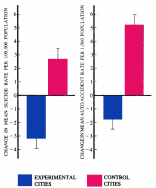 The statistics showed that the trends for 1972 were the same in both the control and 1% cities. During the subsequent 5 years, the control cities followed the same trend of ever increasing numbers, but in the 1% cities the number of car accidents and suicides decreased significantly (p<.001 voor beide).Ref.Scientific Research on Maharishi’s Transcendental Meditation, Collected papers. vol. 4, 317, pp 2479-2486
The statistics showed that the trends for 1972 were the same in both the control and 1% cities. During the subsequent 5 years, the control cities followed the same trend of ever increasing numbers, but in the 1% cities the number of car accidents and suicides decreased significantly (p<.001 voor beide).Ref.Scientific Research on Maharishi’s Transcendental Meditation, Collected papers. vol. 4, 317, pp 2479-2486
Study 5: 30% decrease in crime in 3 Kansas City suburbs
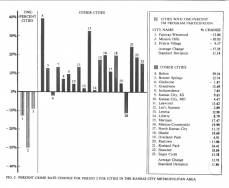 The crime rates in three Kansas City suburbs, where the threshold of 1% of TM practitioners was reached in 1975, was over the subsequent 2 years compared to numbers of the area around Kansas City, and more specifically to all suburbs in the same area, with more comparable demographic variables. Compared to the entire region, crime dropped by 30% (p<.001), compared to cities in the area the decrease was even 36,3% (p<.001).Ref.Scientific Research on Maharishi’s Transcendental Meditation, Collected Papers vol. 4, 319, pp. 2496-2514
The crime rates in three Kansas City suburbs, where the threshold of 1% of TM practitioners was reached in 1975, was over the subsequent 2 years compared to numbers of the area around Kansas City, and more specifically to all suburbs in the same area, with more comparable demographic variables. Compared to the entire region, crime dropped by 30% (p<.001), compared to cities in the area the decrease was even 36,3% (p<.001).Ref.Scientific Research on Maharishi’s Transcendental Meditation, Collected Papers vol. 4, 319, pp. 2496-2514
Study 6: Correlation between the number of TM practitioners and crime decrease in 160 cities
This large scale study was done to find statistical prove that the TM 1% effect is the actual cause of crime decreases observed. A “cross-lagged panel correlation” (CLPC) was carried out across 160 randomly selected cities, a study measuring cause and effect, and asking the question how strong cause (high percentage of TM practitioners) and effect (crime decrease) were correlated, and whether an effect can be detected in the absence of the cause, or a cause without effect. This study showed a significant causative correlation between the percentage of TM practitioners and crime decrease. The study was later repeated across 80 larger cities, with the same result.Ref.Journal of Mind and Behavior, vol. 8, 1987, pp. 67-104
Study 7: Prospective 1% effect study in Lebanon
In order to test the kind of effect achieved through the 1% TM effect in a real war situation, a village with around 10.000 inhabitants was selected in Lebanon at the time of the civil war (1980), and it was declared up front that violence would decrease in this village, compared to other villages in the same region with the same demographic variables. Transcendental Meditation teachers started teaching the TM technique to locals in the village, without explaining the actual purpose of the study. They only spoke of personal advantages of the technique. As soon as the 1% threshold was reached, in the summer of 1982, people looked at the number of “shells” fired (grenades and mortars), the number of deaths and the number of injured over a period of 2 years. As the source for their data they took the largest, most objective newspaper in Lebanon.
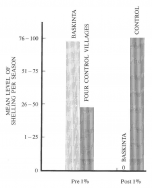
Spring had always been the time of year where most fights occurred. Prior to reaching 1%, 45 mortars were fired in the village in the spring of 1979, 50 in 1980, 1705 in 1981 and 353 in 1982. In the spring of 1983, when 1% of the village had learned TM, not a single mortar or grenade was fired (p<.00001). During the subsequent 2 years not a single death occurred in the village (Baskinta) (p<.005), not a single injury (p<.005), and not a single case of damage to housing (p<.005) as a result of war violence. In the 4 control cities, less than 20 km away from this village, violence increased in the 2 years after the summer of 1982, in comparison to the previous 4 years.Ref.Scientific Research on Maharishi’s Transcendental Meditation, Collected Papers vol. 4, No. 331 pp. 2623-2633
Study 9: Decreased war intensity in 5 areas around the world through Yogic Flying
1400 volunteers trained in the TM sidhi programme and in Yogic Flying offered to participate in a global experiment, the “World Peace Project” that took place from early October to late December 1978. The TM organisation financed the entire project from its own funds and donor funds. The Yogic Flyers traveled to different problem areas around the world where war already existed, or where the situation was dangerously explosive. They stayed in the relevant areas or, where this was not possible for reasons of security, as close to the areas as possible:
Lebanon: (civil war) 100 Yogic Flyers in Cyprus and Syria, 400 Yogic Flyers in a TM sidhi course in Israel close to the Lebanese border
Iran: (explosive situation immediately before the coming to power of Ayatollah Komeini) 206 Yogic Flyers
Thailand: (fear for spreading of war from Cambodia to Thailand): 260 Yogic Flyers
Nicaragua: (civil war, 1200 deaths in September ’78) 140 Yogic Flyers to Nicaragua, and 160 to surrounding countries Honduras, Costa Rica, Guatemala and El Salvador.
Zimbabwe (then Rhodesia, civil war, 1000 deaths in September ’78): 121 Yogic Flyers
The description of the effects of this experiment is full of miraculous events, like how there were daily bombings in Zimbabwe, but from the day the Yogic Flyers arrived the situation calmed, and in the entire country the number of deaths a day dropped by 80%, from 16 to 3, and how the government requested the Yogic Flyers to extend their stay as, whatever it was they were doing, it worked, and how the day after they finally left a bomb attack occurred and the level of violence returned to the level it was at prior to the experiment.
However, to shed these events in a more objective light, researchers worked closely with the Conflict and Peace Data Bank (COPDAB), then the world’s largest database around news events. They collected news from all over the world, national and international media (415.000 events over the previous 30 years) and would score these depending on whether it was positive or negative news, divided into 3 large groups:
- Cooperative Events: events of cooperation, peace
- Verbal hostilities: mild and strongly hostile remarks about the opponent
- Hostile acts: Hostile deeds, from removal of ambassadors to war
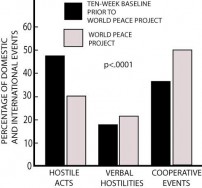 These numbers showed that, during the 10 weeks of the World Peace Project in comparison to the previous 10 weeks, the number of “hostile acts” across the 5 areas dropped by 30%, while the number of “cooperative events” increased by 30% (p<.0001). Later analysis showed that this had nothing to do with the time of year. During the previous time years no differences were noticeable in the same period.Ref.Scientific Research on Maharishi’s Transcendental Meditation, Collected Papers vol. 4 no. 322 pp. 2532-2548
These numbers showed that, during the 10 weeks of the World Peace Project in comparison to the previous 10 weeks, the number of “hostile acts” across the 5 areas dropped by 30%, while the number of “cooperative events” increased by 30% (p<.0001). Later analysis showed that this had nothing to do with the time of year. During the previous time years no differences were noticeable in the same period.Ref.Scientific Research on Maharishi’s Transcendental Meditation, Collected Papers vol. 4 no. 322 pp. 2532-2548Study 8: Improved quality of life in the U.S. State of Rhode Island through Yogic Flying
In this experiment it was publicly predicted up front that a significant effect would be created on the general quality of life in the whole of the State of Rhode Island in the U.S., a state with 750.000 inhabitants, in the summer of 1978 and the subsequent 2 years, in comparison to previous trends in the state and in comparison to the State of Delaware, that was chosen as a control as the demographic variables are very similar.
To rule out chance and alternative explanations it was predicted up front that several variables would all improve simultaneously: Crime, death, fatal car accidents, unemployment, pollution (air quality), alcohol consumption and cigarette consumption. They obtained their data from all relevant government departments. All these different variables were brought together in one statistic called the Quality of Life index.
When the project started, 300 Transcendental Meditation teachers that had also followed the TM Sidhi and Yogic Flying training were brought to the state. They practiced Yogic Flying together in order to immediately create an effect, while also teaching as many people as possible the TM technique (for free) in order to also create a long-term effect.
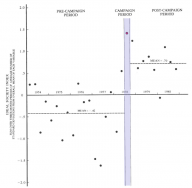 At the end of the project the scientists looked at the data, and found that a very significant improvement had occurred in the summer of 1978 as compared to the previous 5 years. In previous years the Quality of Life index fluctuated a lot, but the general trend was a continuous decrease (average -0,42). During the experimental period, the index jumped to +1,5 (p<.01) and over the subsequent two years remained at an average of +0,7. (p<.01). In the control State Delaware no improvement was reported (click on graph to enlarge it).
At the end of the project the scientists looked at the data, and found that a very significant improvement had occurred in the summer of 1978 as compared to the previous 5 years. In previous years the Quality of Life index fluctuated a lot, but the general trend was a continuous decrease (average -0,42). During the experimental period, the index jumped to +1,5 (p<.01) and over the subsequent two years remained at an average of +0,7. (p<.01). In the control State Delaware no improvement was reported (click on graph to enlarge it).
Just how significant the improvement was is demonstrated through a more thorough analysis of the individual variables, some that were predicted, but also some others that were studied later:
Suicides : dropped by 42% as compared to summer in the previous years, the biggest decrease for the 5 years researched.
Divorces: decreased by 7.7%, the biggest decrease for the 5 years studied.
Fatal car accidents: Increased by 18% annually over the previous 5 years, but decreased by 54% during the summer of ’78. The first decrease ever reported.
Murder: Continuously increased in the previous 5 years, but a decrease of 49% during the summer of ’78 in comparison to summer in the previous year.
Serious crime: Decreased by 22% compared to the previous year, the biggest decrease ever reported.
Car thefts: Lowest number of thefts ever reported for the July-August period, and biggest decrease ever reported
Beer and cigarette consumption: First decrease ever in the summer of ’78.
Total employment: reached a record level in the summer of ’78
Pollution (Carbon Monoxide and Ozone violation days): biggest decrease ever reported
Weather : The summer of 1978 was the sunniest summer in 30 years (warm weather is normally correlated to a crime increase).Ref.The Journal of Mind and Behavior 8: 67–104, 1987. Collected papers vol 4,321 pp. 2521-2531
Study 10: 2000 Yogic Flyers in Massachusetts improve quality of life in all of the U.S.
The first big assembly of Yogic Flyers in one location, also called the “World Peace Assembly”, occurred in the summer of 1979 in the state of Massachusetts. For 6 weeks (from 9 July to 20 August) between 1570 and 2770 Yogic Flyers assembled to conduct their TM b, TM Sidhi programme and Yogic Flying practice together. As according to the formula of the square root of 1% of the entire American population only 1530 Yogic Flyers were required, it was predicted in advance that this assembly would have a measurable influence on the behaviour in all of the U.S.
It was predicted that the following factors would all significantly improve all over the U.S., but that the effect would be even stronger in Massachusetts. Even though a light source spreads light all over a room, the light still shines the brightest closest the source: violent crime, car accidents, plane crashes, 14 different causes of death (including murder and suicides). It was also predicted that the effect of greater positivity in the conscious of the Americans would be noticeable on the American stock exchange (as measured by Standards&Poor’s and Dow-Jones).Ref.Scientific Research on Maharishi’s Transcendental Meditation, Collected Papers vol. 4, no. 323, pp 2549-2563
The results
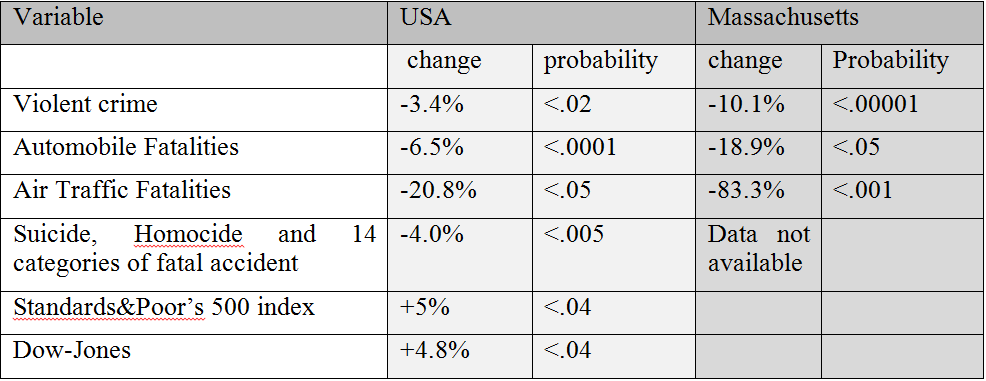
Study 11: Decrease in crime and car accidents in the Netherlands (1981)
Between January 1979 and December 1981 there were 3 periods in which groups of Yogic Flyers assembled, large enough to have an influence on behaviour in all of the Netherlands (376 Yogic Flyers, in line with the formula of the square root of 1% of the population). Two of these 3 assemblies were purposely organised by the Dutch TM organisations, with public predictions to the media that they would have an influence both on crime statistics and the number of car accidents. The third assembly was a large assembly in Germany, not far from the Dutch border, with 900 Yogic Flyers.
In order to paint a realistic picture of the effect of these 3 assemblies, statistics for crime and car accidents were requested for the same months in which the assemblies of Yogic Flyers occurred (January, August, and December) for the past 10 years.
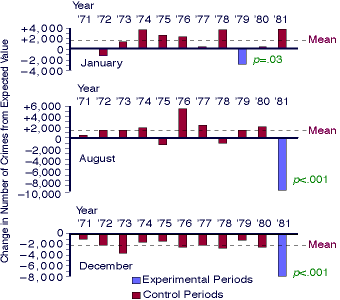 Crime statistics showed that during the 3 assemblies an exceptionally low number of crimes took place in comparison to the previous 10 years (3,000 to 10,000 fewer crimes). The number for car accidents showed a similar result, a significant decrease during the 3 months of the assemblies, in comparison to the previous 10 years (p=.08 tot p=.002).Ref.Scientific Research on Maharishi’s Transcendental Meditation, Collected Papers vol. 4, no. 325, pp 2566-2582
Crime statistics showed that during the 3 assemblies an exceptionally low number of crimes took place in comparison to the previous 10 years (3,000 to 10,000 fewer crimes). The number for car accidents showed a similar result, a significant decrease during the 3 months of the assemblies, in comparison to the previous 10 years (p=.08 tot p=.002).Ref.Scientific Research on Maharishi’s Transcendental Meditation, Collected Papers vol. 4, no. 325, pp 2566-2582
Study 12: Decrease of crime in New Delhi, India
From November 1980 to April 1981 an assembly of Yogic Flyers took place, large enough to influence all 6 million inhabitants of New Delhi (245 Yogic Flyers were required, in line with the formula of the square root of 1%). Crime statistics were requested from local police offices to study whether a change occurred in the number of crimes, as predicted in advance. During the 5 months of the experiment the number of crimes decreased by 11% (p<.0001, what is a p-value?) Statistics of the previous 5 years showed a maximum decrease of 1% during the same period. Possible alternative explanations were sought, but not found.Ref.The Journal of Mind and Behavior 8: 67–104, 1987, Scientific Research on Maharishi’s Transcendental Meditation, Collected Papers vol. 4, no. 326, pp 2583-2588
Improved personal relationships
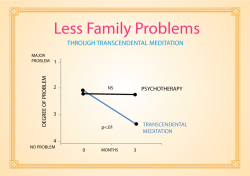 Patients in treatment for Post Traumatic Stress Disorders that were taught the Transcendental Meditation technique showed a significant reduction in family problems after three months, as compared to those receiving psychotherapy treatment, that showed no noticeable change after three months.Ref.Journal of Counseling and Development 64: 212-215, 1985
Patients in treatment for Post Traumatic Stress Disorders that were taught the Transcendental Meditation technique showed a significant reduction in family problems after three months, as compared to those receiving psychotherapy treatment, that showed no noticeable change after three months.Ref.Journal of Counseling and Development 64: 212-215, 1985
Study 17: Decrease in crime in Puerto Rico due to Yogic Flying
In 1984 there was an opportunity for an experiment in Puerto Rico. 185 Yogic Flyers, enough to create an influence for all 3.4 million inhabitants of Puerto Rico, were trained at a local Transcendental Meditation academy, and continued to practice their TM, TM sidhi programme and Yogic Flying together from April to July 1984, although in May they only had 80% of the minimum number, and in June 60%. An analysis of crime statistics nevertheless showed a significant decrease in crime numbers for the entire country, starting in April (p<.025), and an increase again starting July (p<.025).Ref.The Journal of Mind and Behavior 8: 67–104, 1987Ref.Scientific Research on Maharishi’s Transcendental Meditation, Collected Papers Vol. 4, no. 334, pp. 2679-2687
Study 18: Improved quality of life in Israel and reduced violence in Lebanon
Of all the studies on the Maharishi effect, this might be the most impressive one. This study was possible thanks to the generous contribution of William Ellinghaus, at the time general director of the telecom giant AT&T.
A group of scientists organised a prospective study during the summer of 1983 in Jerusalem. According to the formula, square root of 1% of the population, 65 Yogic Flyers would be required to create an influence for Jerusalem, 121 for all of Israel, and 192 for Israel and Lebanon together.
Predictions were recorded by an independent group of scientists: If the group of Yogic Flyers was big enough, the following measurable effects would occur:
In Jerusalem
1. Crime: Decrease in the total number of crimes per day. Source: Social Department Research of the Israeli police.
2. Car accidents: Decrease in the total number a day with personal injuries. Source: municipal authorities of Jerusalem
3. Fires: Decrease in the total number of incidents to which the fire services had to respond during the day. Source: municipal authorities of Jerusalem
In Israel
4. Crime: Decrease in the number of crimes per day (with the exception of Jerusalem), Source: Israeli police
5. Financial markets: Increase for Tel Aviv Stock Exchange shares
6. National mood: Better affective tone of the most prominent story (picture story on the front page) of the Jerusalem Post, according to an independent score of 1 (very negative, unpleasant) to 7 (very positive, optimistic). Scores were blind and used the average scores of two different judges independent from the project (Israeli students)
Lebanon
7. War victims: Decrease in the number of military and civil victims as a result of the Lebanon conflict, as reported in the major daily Israeli newspapers, the International Herald Tribune and the BBC World Service.
8. War intensity: Improvement in the scale of the intensity in the hostilities in Lebanon every day, as reported in news stories in the Jerusalem Post. The 5 point scale varied from 0 (no reports of fights) to 4 (full war). The rating was blind in relation to data and incidents and the analysis used the average of three independent judges that were unaware of the purpose of the experiment.
The purpose of the experiment was to create a constant group of 200 participants over a period of the two months of the experiment from 1 August to 30 September 1981, but because the group of Yogic Flyers consisted entirely of volunteers, this was practically impossible. Some could only stay for a few weeks before they returned to work or study. As a result, the number of Yogic Flyers fluctuated over the 8 weeks of the study. Here is a graph of the number of Yogic Flyers (MTUF stands for the Maharishi Technology of the Unified Field).
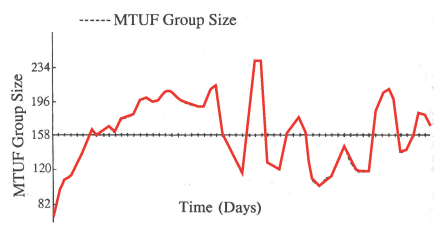
However, the fluctuations didn’t prove to be too much of a challenge for the researchers. Considering the daily data available to them on all 8 variables, they were also able to create a daily graph of how these fluctuated, and consider whether they were able to make a statistical correlation between the number of Yogic Flyers and the 8 variables under scrutiny. All eight were brought together into one index in line with acceptable statistical methods, and the index was then plotted over the 60 days of the study. When the scientists saw the study they almost fell off their chairs. No statistic was required at all to calculate the correlation, the overlap was so clear that anyone could see it with their own eyes (r = -.57 p<.0001).
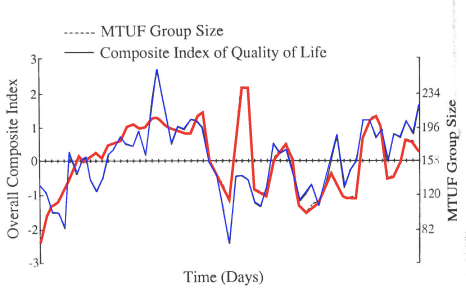
Normally, if one were to plot the fluctuations of 8 different, uncorrelated variables, the graph should look quite flat, as random fluctuations normally cancel. Not a single investor with a sound mind would base his purchase decision on the number of fires in Jerusalem. If these 8 could fluctuate so strongly (fluctuations of -3 to +3 standard deviations are very exceptional, in particular if there are 8 independent variables simultaneously) then there had to be something influencing all 8 together.
It is like someone turning the knob on a light dimmer and witnessing, full of surprise, the light increase and decrease. Instead of the light, we were witnessing the quality of the unified field at the source of everyone’s thoughts in Israel and Lebanon (see qualities unified field), that ultimately all came down to unity and positivity. That same source created more optimism among investors on the stock exchange, a stronger feeling of connectedness with fellow human beings on the war fields in Lebanon, causing a reduction in violence and fewer war victims (from an average of 24.5 deaths a day to 1.5 on days where there were enough flyers to influence Lebanon). That same source also created more optimism in newspapers, and more harmony and order in society, causing less accidents.
This study was so impressive, especially because the data all came from fully objective sources, that it resulted in one of the most prestigious publications to date, in the Journal of Conflict Resolution, vol. 32, no.4, Dec 1988, pp. 776-812. The process to get published nevertheless took 2 years, and the editor of the journal wrote the following note:
“The following article presents and tests a hypothesis that will strike most readers (myself included) as, to say the least, unorthodox…Yet the hypothesis seems logically derived from the initial premises, and its empirical testing seems competently executed. These are the standards to which manuscripts submitted for publication in this journal are normally submitted.”
Decreased Insomnia in Prison Inmates
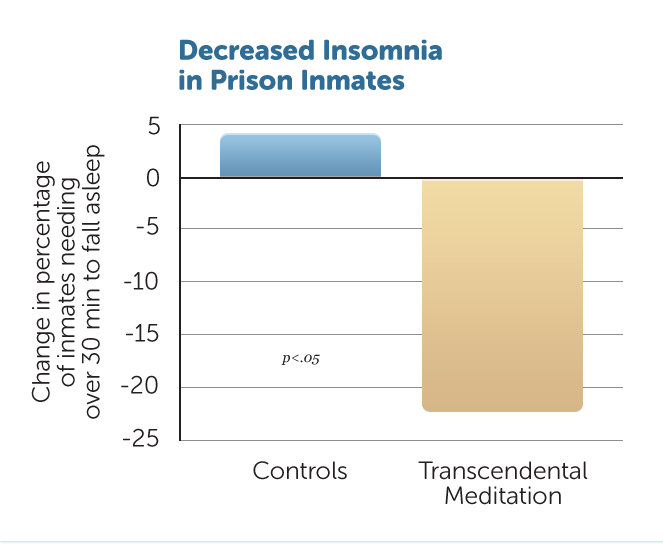 Maximum security prison inmates who learned the Transcendental Meditation Programme showed decreased insomnia and better quality of sleep in comparison to controls.Ref.Criminal Justice and Behavior 5: 3–20, 1978
Maximum security prison inmates who learned the Transcendental Meditation Programme showed decreased insomnia and better quality of sleep in comparison to controls.Ref.Criminal Justice and Behavior 5: 3–20, 1978
Decreased Anxiety in Traumatic Stress Patients
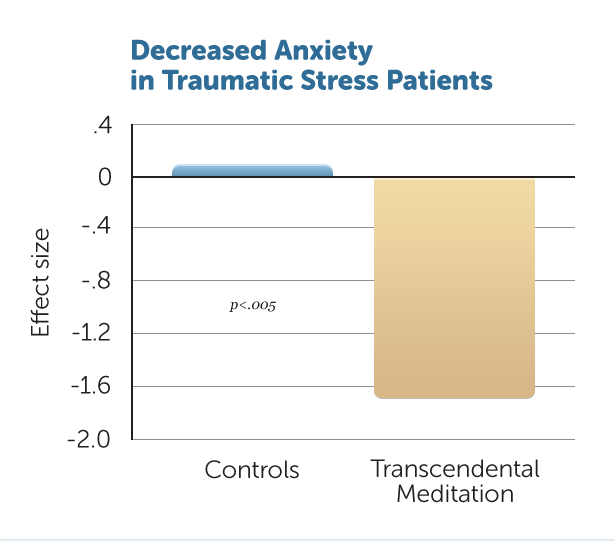 Patients seeking treatment for traumatic stress who learned the Transcendental Meditation Programme showed significantly decreased anxiety in comparison to those receiving psychotherapy.(p<.005)Ref.Journal of Counseling and Development 64: 212-215, 1985
Patients seeking treatment for traumatic stress who learned the Transcendental Meditation Programme showed significantly decreased anxiety in comparison to those receiving psychotherapy.(p<.005)Ref.Journal of Counseling and Development 64: 212-215, 1985
Decreased Anxiety in Industrial Workers
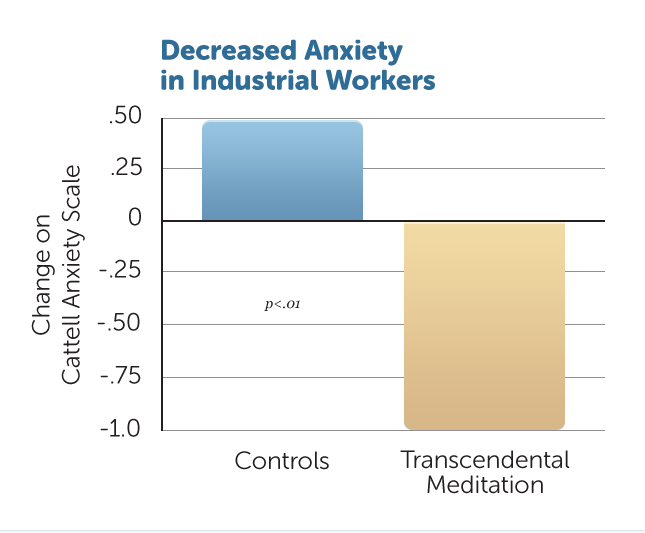 A study conducted at Sumitomo Heavy Industries by the Japanese National Institute of Industrial Health found decreased anxiety in workers who learned the Transcendental Meditation Programme, in comparison to control workers.Ref.Japanese Journal of Industrial Health 32: 656, 1990
A study conducted at Sumitomo Heavy Industries by the Japanese National Institute of Industrial Health found decreased anxiety in workers who learned the Transcendental Meditation Programme, in comparison to control workers.Ref.Japanese Journal of Industrial Health 32: 656, 1990
Study 18: Decrease in crime and deaths in Manila, Philippines
In December 1979 a business man in Manila decided to create a group of Yogic Flyers among the employees of his company. As part of their working hours, employees could practice TM, the TM sidhi programme and Yogic Flying in the morning and evening. It was then decided to organise a new experiment, with predictions up front that crime and deaths would decrease significantly both in Manila and the Philippines as a whole. The number of Yogic Flyers taking part in the experiment was 400, which was more than what was required for Manila alone (300) but less than required for all of the Philippines (750). It was therefore decided to make an index with numbers for both.
What was interesting about this experiment was that the group was formed spontaneously in December 1979, but that, due to circumstances, several employees had to leave the location, causing the group to shrink over the following 2 years, until only about half remained at the end of the study in December 1981. When the numbers of the Index were studied, a significant decrease in the number of crimes and deaths showed in December 1979 (p<.025), followed by a gradual increase until December 1981, which seemed to quite precisely follow the number of Yogic Flyers (p<.001).Ref.The Journal of Mind and Behavior 8: 67–104, 1987,Scientific Research on Maharishi’s Transcendental Meditation, Collected Papers vol. 5, no. 401, pp. 3151-3171
Study 19: Decrease in crime in Manila, Philippines (1984)
In 1984 the government organised a large-scale project to bring Transcendental Meditation to different schools and prisons in the Philippines. 1500 Transcendental Meditation teachers (that had also followed TM sidhi and Yogic Flying training) traveled to the Philippines to take part in the project, and this was a good opportunity for a new experiment. The Yogic Flyers were spread out over the country and there was no opportunity to create one group large enough to influence all of the Philippines. However, the group was large enough to influence Manila. It was therefore predicted beforehand that crime in Manila would decrease in the experimental period of 17 August 1984 to 24 January 1985, 114 weeks in total. According to the Time Series Analysis of data of the local police, crime during those 114 weeks decreased by 12,1% percent (p<.005).
This study, along with earlier studies in Manila, New Delhi, Puerto Rico and Rhode Island, was accepted for publication in 1987 in The journal of Mind and Behaviour. Each of these 5 studies demonstrated an exceptional effect on crime, each time predicted up front, in 4 completely different areas around the world. The combined chance of such exceptional decrease in crime occurring 5 times by coincidence was smaller than one in one million (p<.000001). The editor of the journal placed the following note in the publication:
“I Decided to publish. The theory being proposed was a complete departure from the norm in either psychology or sociology, but this was a study well-done. The statistical evidence was persuasive. What I had to consider is that judging new ideas in any scientific field is an extremely delicate task. On the one hand, you never want to propound errors. On the other hand, you need to keep the field open for innovation and progress. I’m afraid that many times, new ideas don’t lose out on their merits. They lose out because established people in the field don’t want to see their power eroded by new ideas which threaten their expertise and authority. In any event, Michael Dillbeck [the author of the study] had written a strong paper with solid evidence. I didn’t see how I could deny that paper publication.”
Longer lives for heart patients
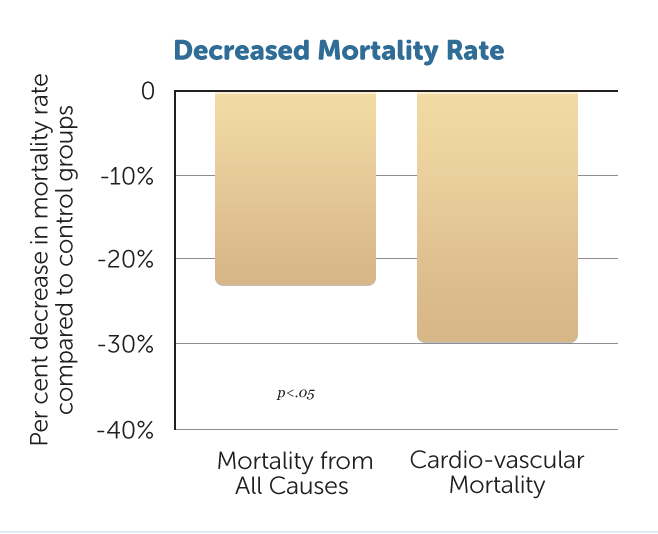 This study in collaboration with the American National Institute of Health followed mortality patterns over a period of 19 years after adults with high blood pressure were taught the Transcendental Meditation technique, or participated in controlled interventions. The results showed a 23% decrease in mortality rates by all causes, and a 30% decrease in mortality rates for heart diseases in the TM group, as compared to the control group.Ref.American Journal of Cardiology 95: 1060–1064, 2005
This study in collaboration with the American National Institute of Health followed mortality patterns over a period of 19 years after adults with high blood pressure were taught the Transcendental Meditation technique, or participated in controlled interventions. The results showed a 23% decrease in mortality rates by all causes, and a 30% decrease in mortality rates for heart diseases in the TM group, as compared to the control group.Ref.American Journal of Cardiology 95: 1060–1064, 2005
Study 24: Higher quality of life in the U.S. (1960-1983)
In 1973 the Transcendental Meditation organisation founded its own university, which purchased a university campus in 1975 from another private education institute in the village of Fairfield in the state of Iowa in the U.S. A community of Yogic Flyers developed around the university, people from all over the U.S. moved to this small village to together practice their TM, TM sidhi programme and Yogic Flying. From early 1980 onwards the group was so large that the influence, combined with the millions of individual TM practitioners, was big enough to reach everyone in the U.S. (1520 Yogic Flyers according to the square root of the 1% formula).
In order to test this, the researchers compiled an index of the Quality of Life comprising several variables that would normally be uncorrelated, and considered whether the TM and Yogic Flying practice had a noticeable influence on the index. The following 12 social variables were incorporated into the index:
- Number of crimes
- Number of civil court cases
- Number of infectious diseases
- Number of child deaths
- Number of suicides
- Number of cigarettes per capita
- Alcohol consumption per capita
- Gross National Product per capita
- Number of patent applications
- Number of diplomas issued per capita
- Number of divorces
- Number of fatal traffic accidents
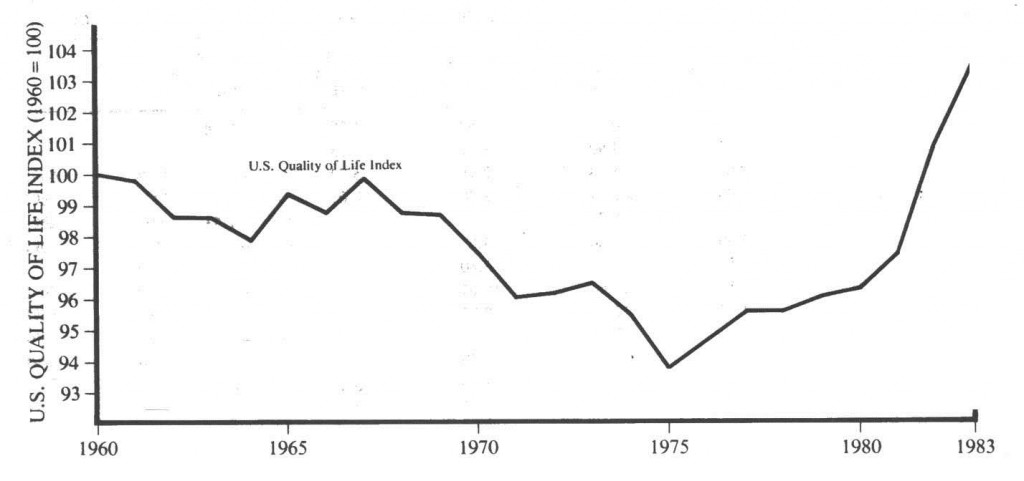
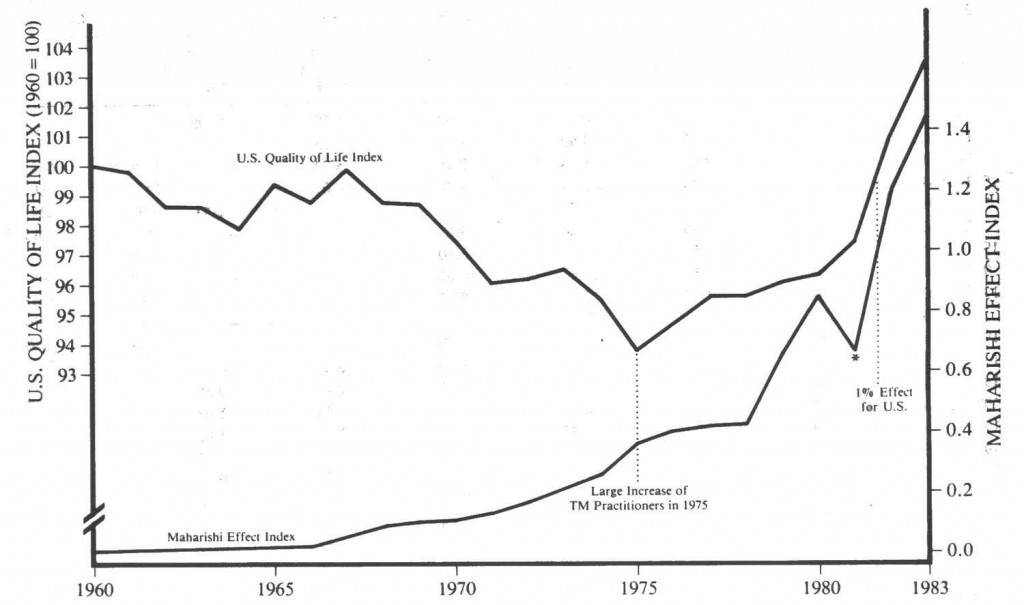
The reversal in the quality of life index appears to coincide with a large increase in the number of TM practitioners in the U.S. But the correlation between the number of Yogic Flyers in Fairfield, responsible for the strong increase in the Maharishi effect index from 1980, and the quality of life index, appeared to be much stronger (p<.0001). From a casual statistic analysis of the numbers, they were able to say with a large degree of certainty that the increase of the Maharishi-effect index was the cause of the increase in the Quality of Life index (p<.0001). According to statistical calculations, increases in the Quality of Life index from 1981 to 1983 could be ascribed to the Maharishi-effect.
When we look at the twelve variables, we get a much better idea of what this significant increase in the quality of life index means. From the 12 variables, 11 showed a significant improvement (only the number of suicides did not improve), and in 7 records were broken.
Crime: From 1981 to 1983 the number of crimes decreased in three consecutive years, something that had never happened before (-0.78% in ’81, -4.3% in ’82, and -7.6% in ’83). This meant 1.300.000 fewer crimes in 1982 and 1983, principally created by the 1600 Yogic Flyers.
Civil court cases: Due to a degree of harmony in the collective conscious, civil suits were only filed when all other amicable methods to solve conflicts have failed. The number decreased by 7.6 % in 1982 and another 11.5 % in ’83, reaching the lowest number ever reported.
Infectious diseases: Decreased by 4.23% in ’82 and by 7.02 % in ‘83 (strongest decrease in 16 years)
Cigarette usage : Decreased by 1.90 % in ’82 and 6.26 % in ’83 (biggest decrease in the 23 years of the study.)
Alcohol usage: Decreased by 3.52 % in ’82 and 2.64 % in ‘83. (second and third largest decreases in 23 years)
Number of diplomas issued: increased slightly (0.31% and 0.98%) after decrease in the previous five years
Divorces: Decreased by 4.46 % in 1982 (a decrease 3 times bigger than the previous record set 21 years earlier) and another 0.18 % in 1983 (the only time that the number of divorces decreased two years in a row)
Fatal accidents: Decreased 10.95 % in 1982 (biggest decrease ever, apart from 1975, when the 55 mph speed limit was introduced in the U.S.). The prominent magazine Motor Trend wrote at the end of 1982:
“Everyone loves a mistery, and the sudden 10% drop in 1982 highway fatalities has created a good one. Various sources postulate reasons for the decline…but the fact is, nobody knows why”
The magazine and other car organisations predicted an increase for the subsequent year, but another decrease in the number of car accidents of 4.60% was reported in 1983.
In order to provide an extra argument that the increase in the Quality of Life index from 1981 to 1983 was in fact due to the group of Yogic Flyers in Iowa, the numbers for the U.S. as a whole were compared to the numbers for Iowa. One source of light can illuminate an entire room (or an entire country), but the light will always shine brightest closest to the light source. Accordingly, a stronger improvement was predicted for Iowa than for the U.S. in general, a predicted that was confirmed by the numbers.Ref.Social Science Perspectives Journal, (2 (4), 127-146)
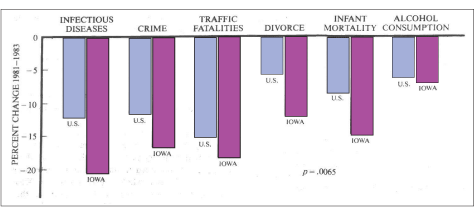
3000 Buddhist Monks learn Transcendental Meditation
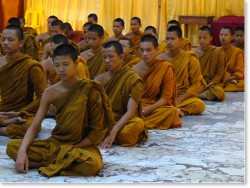 There are many types of meditation on the market in the West that were inspired by Buddhism, such as Mindfulness and Vipassana techniques. But in the East some experts in Buddhism have opted for Transcendental Meditation over other techniques. More than 3000 monks spread out over 100 monasteries in South East Asia have learned the TM technique, and enjoy it’s simplicity and effortlessness, as well as the deep effects that it brings.
There are many types of meditation on the market in the West that were inspired by Buddhism, such as Mindfulness and Vipassana techniques. But in the East some experts in Buddhism have opted for Transcendental Meditation over other techniques. More than 3000 monks spread out over 100 monasteries in South East Asia have learned the TM technique, and enjoy it’s simplicity and effortlessness, as well as the deep effects that it brings.
Insomnia cured among Indian patients
75 Indian patients with health problems for which regular medical treatment offered no cure (33 different problems) were taught the Transcendental meditation technique, and 67 of them continued to regularly practice the technique. In the long term 61 out of 67 patients had good results (significant improvement or complete disappearance of the problem) and 24 had very good results (with a very fast, dramatic or unexpected full recovery).Ref. Scientific Research on TM: Collected Papers vol 3, 239, pp. 1826-1829
For 11 cases of insomnia, all 11 patients showed very good results.
America’s most famous doctor supports TM
Dr. Mehmet Oz is a heart specialist, professor at the Columbia University, and director of the cardiovascular institute in a prominent New York hospital. He is the author of 6 best-selling books on health; he has his own television show in America, and he is a weekly guest on Oprah Winfrey’s shows. In 2008, Time Magazine placed Dr. Oz as No. 44 on their list of the 100 most influential people in the world. On this video clip, Dr. Oz describes the benefits of TM in the field of cardiovascular diseases. (English)
Maharishi School in England recognised by British Government
 After 20 years as a private school, the Maharishi School in Skelmersdale, Northern England is now recognized as a public school and therefore entitled to public funds. The main reason for the recognition is the spectacular results that the Maharishi School students achieve, year after year. In 2002, the Maharishi School ranked No. 14 of all the 4400 schools in England. Unlike all the other top schools, the Maharishi School has an open door admission policy. All other top schools can only retain their reputation by accepting the brightest students, The Maharishi School achieved its top status by developing the students’ full brain potential, (See brains.) and by creating the basis for the student’s success. (See success.)
After 20 years as a private school, the Maharishi School in Skelmersdale, Northern England is now recognized as a public school and therefore entitled to public funds. The main reason for the recognition is the spectacular results that the Maharishi School students achieve, year after year. In 2002, the Maharishi School ranked No. 14 of all the 4400 schools in England. Unlike all the other top schools, the Maharishi School has an open door admission policy. All other top schools can only retain their reputation by accepting the brightest students, The Maharishi School achieved its top status by developing the students’ full brain potential, (See brains.) and by creating the basis for the student’s success. (See success.)
Howard Stern explains how he learned TM.
It’s quite remarkable for a radio personality to earn more than most Hollywood movie stars. In a recent interview with the famous American TV talk show host David Letterman, Howard Stern revealed his salary from his last contract: $500 million. In the same interview, he talked with Letterman about how he learned Transcendental Meditation 40 years ago after seeing how it saved his mother from manic depression, and how he still practices the TM technique on a daily basis. (See video: English).
Study 33: Crime decrease in Merseyside, England
In 1988 Merseyside, a city of 1.5 million, was the most criminal metropolis in England. So when a group of Yogic Flyers in March of that year predicted on television that they were going to decrease crime significantly, not a lot of people took them serious. A few hundred Yogic Flyers had formed a small community in the town of Skelmersdale, nearby Merseyside. The intention was to live together and to practice TM, TM Sidhi and Yogic Flying together.
In March 1988 they had built a hall allowing them to do this, and the group had grown to 120 regular Yogic Flyers, theoretically large enough to create an influence for all of Merseyside. All these Yogic Flyers were normal everyday people, with their own jobs and households, but twice a day, before and after work, they would come together to create the influence, for themselves and their environment.
The graph of the number of crimes over the next 5 years looks as follows.
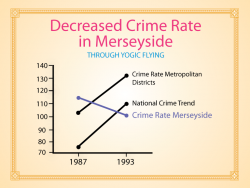 In contrast to the increasing crime trends in both the large metropolis cities in England and in general, the number of crimes in Merseyside decreased significantly (p<.00006). After 5 years Mersey had the lowest crime rate in all of England. Crime had decreased by 45% as compared to its own trends, and by 60% as compared to national trends. Merseyside was the only metropolis where crime decreased.
In contrast to the increasing crime trends in both the large metropolis cities in England and in general, the number of crimes in Merseyside decreased significantly (p<.00006). After 5 years Mersey had the lowest crime rate in all of England. Crime had decreased by 45% as compared to its own trends, and by 60% as compared to national trends. Merseyside was the only metropolis where crime decreased.
Other factors also started improving. The number of suicides decreased to the lowest overall in all of England, and other violent or accidental deaths by 1992 was the second lowest of all metropolis districts. In 1985, only 40% of all visitors went to Merseyside for pleasure, by 1990 this had increased to 80%.
The economy in Merseyside also drastically improved. Whereas the metropolis previously had only known decrease, in the early 1990s it became the model for economic advancement. In 1995 an article was published in a prominent newspaper, the Daily Mail, with the title: “Merseyside is my heaven on earth”.
Researchers calculated that the Yogic Flyers had prevented a total of 255.000 crimes. The average cost per crime was estimated at £5000 (not taking into account human suffering), which therefore implied a total saving for the government of £1.250.000.000.
For every hour that a Yogic Flyer did his thing, this implied savings for the local government of £3000. Even if the Yogic Flyers were paid a respectable salary of £30 an hour, the total cost would still be 99% lower than the current cost of tackling crime, while clearly being a lot more efficient.
This is an example of what is possible in terms of costs savings for the government, but given the exponential growth of the effect of the number of Yogic Flyers, not the best example. This was only a group of 120 Yogic Flyers. A group 10 times as big could influence 100 times more people, as some studies have shown. This means that the cost per created influence is 10 times lower.Ref.Journal of Psychology, Crime & Law (1996, vol. 2, pp. 165-174)Ref.Scientific Research on Maharishi’s Transcendental Meditation, Collected Papers vol 6, 488, pp 4079-4085
Study 35: Crime decrease in Washington DC (1994)
This study was the most public study to date. A group of scientists announced that they would, through a large group of 4000 Yogic Flyers, decrease serious crimes (murder, rape and harassment) in Washington DC by 20% during the summer of 1994. It was also predicted that the quality of life would improve, measured by a previously specified index, and that the government would start functioning more efficiently, objectively measured through an improvement in the “approval rate” of President Clinton (whose public support was at an all-time low immediately before the study, with no signs of improvement). This prediction was faxed to 1900 fax numbers, including scientists, all senators, other top politicians and 375 different media outlets. The prediction made it on to television and was reported by a good number of media outlets, including CNN, Associated Press, the Washington Post, and the Washington Times.
At that time Washington was the most violent capital city in the world. From 1986 to 1992 the crime rate increased by 77% (11% annually), despite a growing budget to fight crime (1 billion USD annually for crime in Washington DC alone). When the head of police heard this prediction, he wasn’t just a little bit skeptical. He even appeared on television, and declared:
“the only thing that will reduce crime by 20% is 20 inches (50cm) of snow, “mental harmony” alone won’t do it.”
The experiment took place in the summer, and “20 inches of snow” was therefore his way of saying: “Impossible”.
To rule out any doubt about the full objectivity of this study, a 24 member committee was put together, comprising scientists in the fields of crime and sociology, politicians, and members of the Washington Police Force. All members had one thing in common, they had no connection to the Transcendental Meditation organisation.
This committee decided through discussion what statistic information was to be used to predict crime, and to thereby see whether the crime rate during the time of the experiment deviated from the predicted crime. Their statistic model was tested against the actual numbers of the previous 5 years and appeared to very accurately predict crime. (The most important variable turned out to be crime. The higher the temperature, the more crimes).
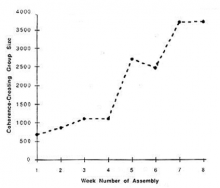 The experiment started in early June, but as with many other previous experiment the Yogic Flyers were all volunteers, having to take time off work and traveling on their own cost to Washington DC. The result was that the number of Yogic Flyers gradually increased over the 8 weeks of the experiment, until it reached 4000 in the final 2 weeks.
The experiment started in early June, but as with many other previous experiment the Yogic Flyers were all volunteers, having to take time off work and traveling on their own cost to Washington DC. The result was that the number of Yogic Flyers gradually increased over the 8 weeks of the experiment, until it reached 4000 in the final 2 weeks.
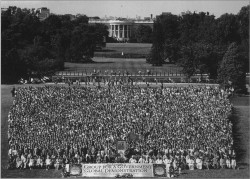
To celebrate their assembly, they decided to take a small group photo in front of the white house (click on the picture to enlarge it).
This gradual increase made the experiment that much more interesting than the researchers had originally thought. If the heavy crime rate was to follow this curve (in the opposite direction, less crimes for more Yogic Flyers), than the correlation would be much stronger.
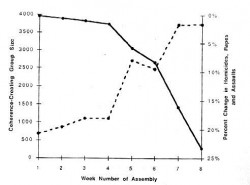 This turned out to be exactly the case. At the time of the maximum number of Yogic Flyers, the number of heavy crimes had decreased by 23%. The correlation was so strong, and the decrease so significant, that the probability of chance was 1 in 500 million (p=.000000002). Further analysis showed that if the group of Yogic Flyers could have stayed longer, crime would have dropped by 48%.
This turned out to be exactly the case. At the time of the maximum number of Yogic Flyers, the number of heavy crimes had decreased by 23%. The correlation was so strong, and the decrease so significant, that the probability of chance was 1 in 500 million (p=.000000002). Further analysis showed that if the group of Yogic Flyers could have stayed longer, crime would have dropped by 48%.
The other predictions came true too. The Quality of Life index showed a dramatic improvement, with improvement in all factors included in the index (psychiatric emergency assistance requests p=.009, media attention for Clinton p=.01, Complaints to the police p=.01, Trauma incidents p=.01, and fatal accidents p=.045).
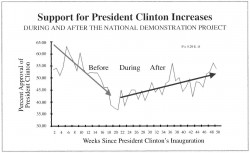 President Clinton’s approval rate also showed a dramatic, unexplainable reversal during the experiment. (p<.000000005).
President Clinton’s approval rate also showed a dramatic, unexplainable reversal during the experiment. (p<.000000005).
The Washington Post was unable to explain why both the press and the public were suddenly a lot more positive about the president. On 18 July 1994, in the middle of the experiment, they wrote:
“The Clinton Administration appears to have revived…Washington has relaxed. But such a swift reversal of political fortune is not easy to account for. [We] may logically wonder whether Clinton really turned things around or if something else is going on…almost mysteriously and almost overnight, in the face of government distress, the press seems to be transformed…Bill Clinton, after all, is still Bill Clinton…[He] hasn’t changed – and neither has the press”
This study was finally accepted for publication in one of the most prestigious scientific journals in the field of sociology, Social Indicators Research, although it took them three years to look at all aspects of the research prior to publication. The Washington DC police force co-signed the study as co-authors.
The cost to assemble 4000 Yogic Flyers for this 2 month experiment was $8 million, fully paid by the Transcendental Meditation organisation, several donors and Yogic Flyers. The normal police cost for this same period was $166 million, without succeeding to lower crime.Ref.Social Indicators Research (1999, vol. 47, no. 2)
Decrease in hospitalisation
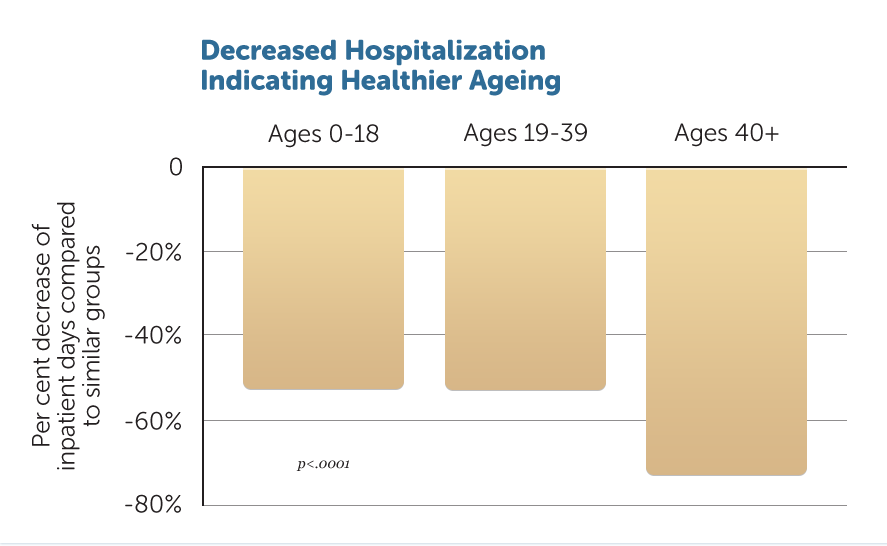 A study analysed five years of medical insurance details of circa 2000 practitioners of Maharishi’s Transcendental Meditation technique. The study demonstrated a 50 to 70% decrease in hospitalisations, both for medical and surgical procedures, as compared to the average of all other insured. The study had a p-value of p<.0001 what is a p-value? The fact that the decrease is bigger for older patients indicates a healthier ageing process.Ref.Psychosomatic Medicine 49: 493–507, 1987
A study analysed five years of medical insurance details of circa 2000 practitioners of Maharishi’s Transcendental Meditation technique. The study demonstrated a 50 to 70% decrease in hospitalisations, both for medical and surgical procedures, as compared to the average of all other insured. The study had a p-value of p<.0001 what is a p-value? The fact that the decrease is bigger for older patients indicates a healthier ageing process.Ref.Psychosomatic Medicine 49: 493–507, 1987
Growth in Field Independence among Taiwanese students
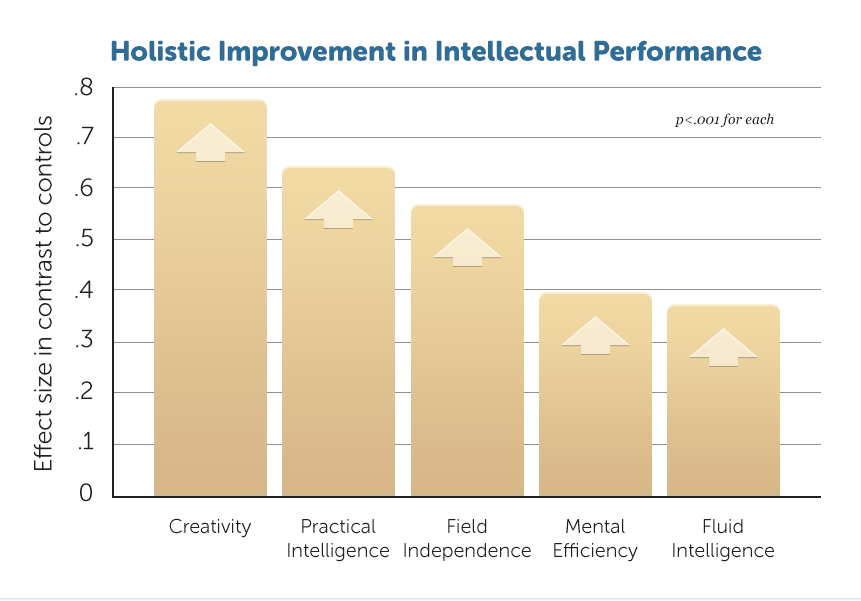 362 Taiwanese school children were randomly divided into 4 groups, one TM group and three control groups: a group in which students were allowed a nap, a group in which students were given no special attention, and a group that practiced contemplation meditation. After 6 to twelve months the TM group showed very significant improvement on 5 different scales of intellectual capability, including Field Independence, in comparison to the 3 control groups. The difference in growth with the control groups was so great and so consistent that the probability of chance was 1 in 25 million, p=.00000004. (what is a p-value?) The TM students also showed significantly reduced stress symptoms.Ref.Intelligence 29: 419–440, 2001
362 Taiwanese school children were randomly divided into 4 groups, one TM group and three control groups: a group in which students were allowed a nap, a group in which students were given no special attention, and a group that practiced contemplation meditation. After 6 to twelve months the TM group showed very significant improvement on 5 different scales of intellectual capability, including Field Independence, in comparison to the 3 control groups. The difference in growth with the control groups was so great and so consistent that the probability of chance was 1 in 25 million, p=.00000004. (what is a p-value?) The TM students also showed significantly reduced stress symptoms.Ref.Intelligence 29: 419–440, 2001
Development of Intelligence—Increased IQ in University Students
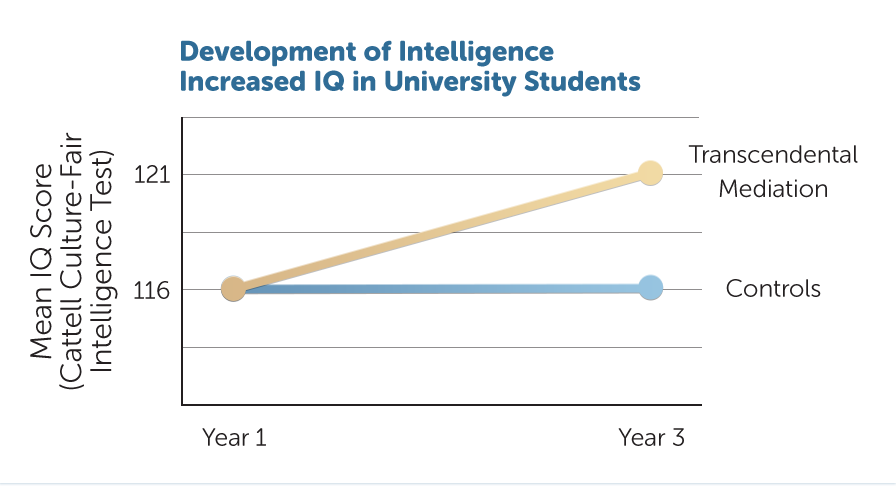 Development of intelligence – increased IQ in university students
Development of intelligence – increased IQ in university students
University students that practiced Maharishi’s Transcendental Meditation technique and the TM Sidhi programme had a significantly increased IQ. These students were over the age of 18, and an increase in IQ was therefore theoretically impossible. The control group indeed did not show an increase. The difference between the TM group and the control group was a p-value of <.0001 (what is a p-value?)Ref.Personality and Individual Differences 12: 1105–1116, 1991
Faster growth in creativity among students
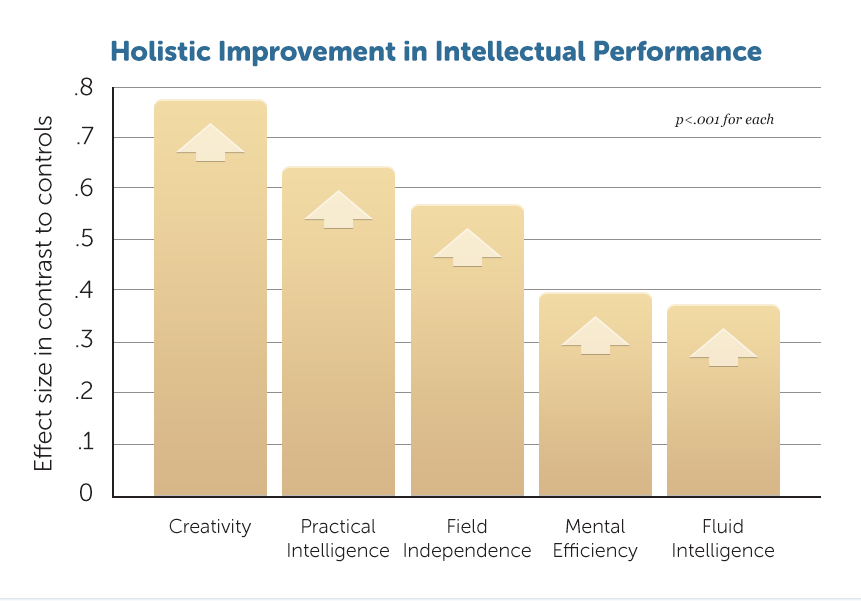 In Taiwan 362 secondary school students were randomly divided into 4 groups, a TM group and 3 control groups. The 3 control groups included: 1) a resting group, 2) a group practicing contemplation meditation, and 3) a group which received no specific attention. After 6 to 12 months the TM group showed a significant improvement in 5 different scales of intellectual capability, including a scale for “whole brain creativity” as compared to the 3 control groups. The difference in growth was so significant and so consistent that the probability of chance was 1 in 1.2 billion p=.0000000008. (what is a p-value?) The TM students also showed a significant decrease in stress symptoms.Ref.Intelligence 29: 419–440, 2001
In Taiwan 362 secondary school students were randomly divided into 4 groups, a TM group and 3 control groups. The 3 control groups included: 1) a resting group, 2) a group practicing contemplation meditation, and 3) a group which received no specific attention. After 6 to 12 months the TM group showed a significant improvement in 5 different scales of intellectual capability, including a scale for “whole brain creativity” as compared to the 3 control groups. The difference in growth was so significant and so consistent that the probability of chance was 1 in 1.2 billion p=.0000000008. (what is a p-value?) The TM students also showed a significant decrease in stress symptoms.Ref.Intelligence 29: 419–440, 2001
Improved results among students
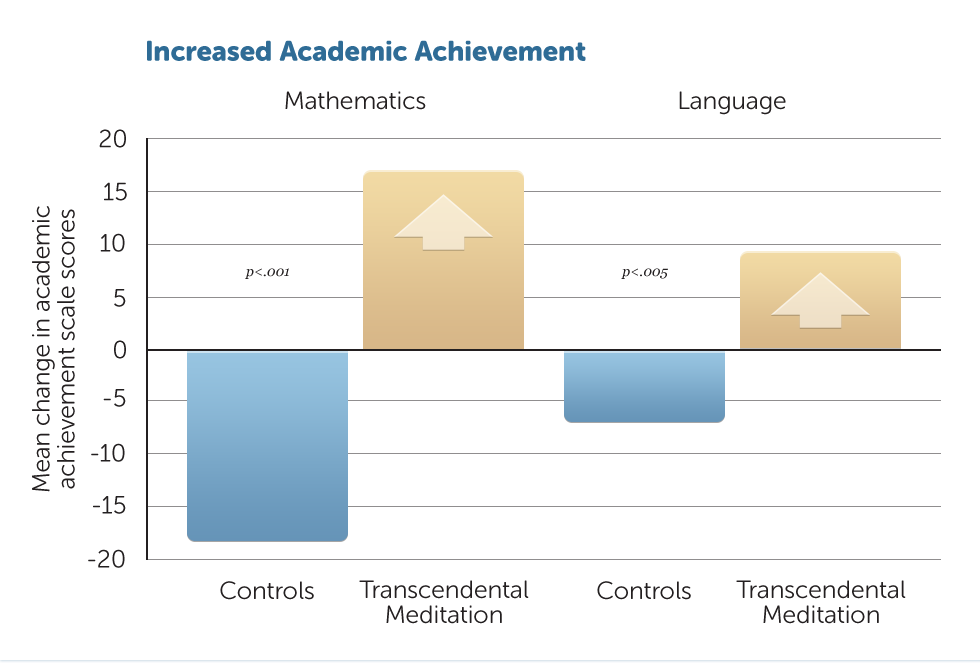 High school students that were taught the Transcendental Meditation technique and practiced twice a day as part of their school day, showed significant improvements in test results for math (p<.001) and language (English) (p<.005) after three months of practice, as compared to control students.Ref.Education 131: 556–564, 2011
High school students that were taught the Transcendental Meditation technique and practiced twice a day as part of their school day, showed significant improvements in test results for math (p<.001) and language (English) (p<.005) after three months of practice, as compared to control students.Ref.Education 131: 556–564, 2011
Higher test scores among students
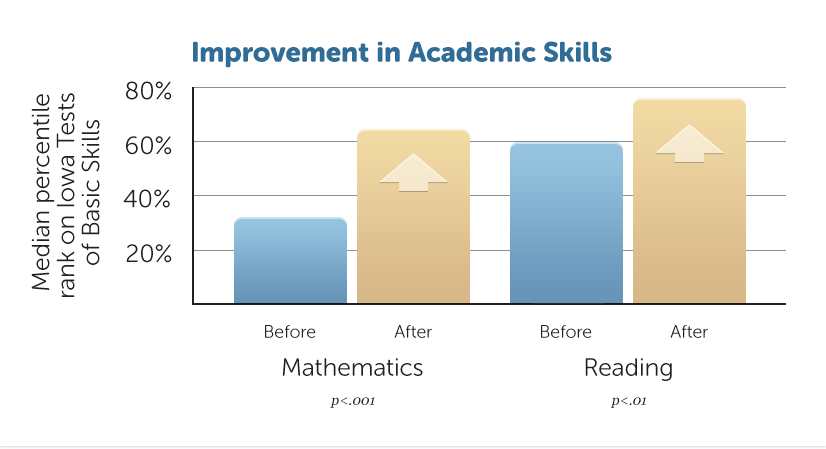 Students in secondary education that were taught Maharishi’s Transcendental Meditation technique, within one academic year showed significant improvement on national standardised tests of basic capabilities. (reading p<.01, math p<.001)Ref.Education 107: 49–54, 1986
Students in secondary education that were taught Maharishi’s Transcendental Meditation technique, within one academic year showed significant improvement on national standardised tests of basic capabilities. (reading p<.01, math p<.001)Ref.Education 107: 49–54, 1986
Improved academic results in university
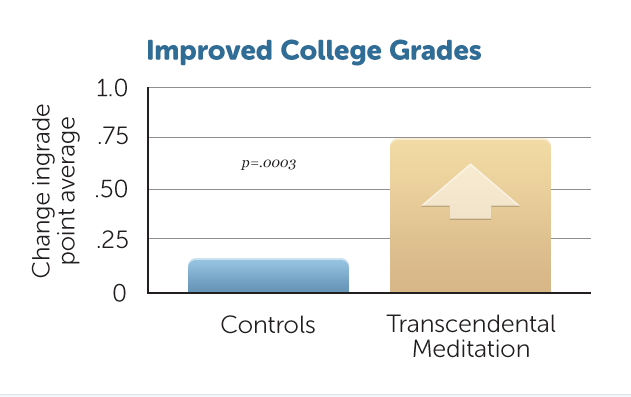 University students that were taught Maharishi’s Transcendental Meditation technique showed a significant increase in average test scores (Grade Point Average) in the subsequent three academic test periods, as compared to control students. (p=.0003)Ref.Scientific Research on Maharishi’s Transcendental Meditation Programme: Collected Papers, Volume 1: 396–399, 1977
University students that were taught Maharishi’s Transcendental Meditation technique showed a significant increase in average test scores (Grade Point Average) in the subsequent three academic test periods, as compared to control students. (p=.0003)Ref.Scientific Research on Maharishi’s Transcendental Meditation Programme: Collected Papers, Volume 1: 396–399, 1977
Correlation between length of TM practice, academic results and IQ
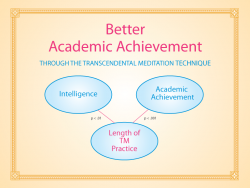 The length of practice of Maharishi’s Transcendental Meditation technique was significantly correlated to both academic results (r=.52, p<.001) and IQ (r=.59, p<.01) among students in a high school where the Transcendental Meditation technique was practiced as part of the curriculum.Ref.Abstracts of Papers of the Annual Meeting of the Mid-western Educational Research Association, 1988, p.6, Chicago
The length of practice of Maharishi’s Transcendental Meditation technique was significantly correlated to both academic results (r=.52, p<.001) and IQ (r=.59, p<.01) among students in a high school where the Transcendental Meditation technique was practiced as part of the curriculum.Ref.Abstracts of Papers of the Annual Meeting of the Mid-western Educational Research Association, 1988, p.6, Chicago
Fewer doctor visits
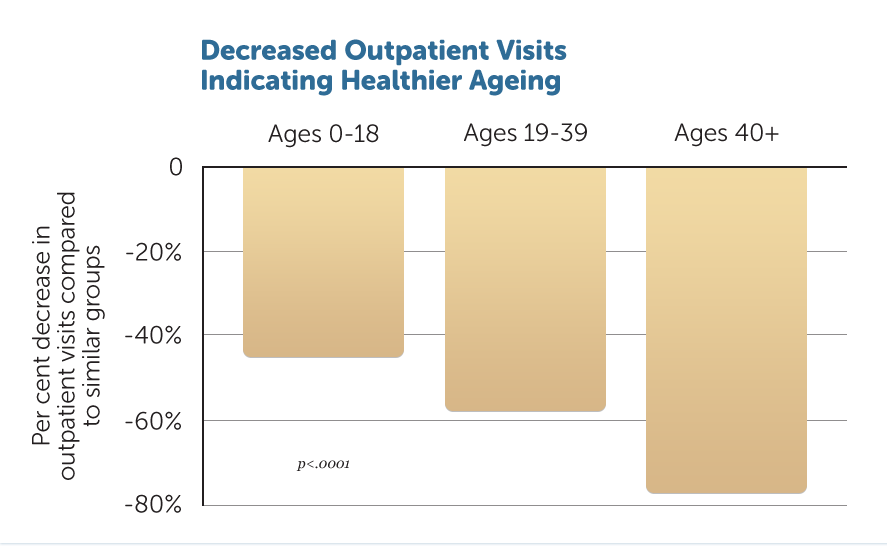 A study analysed five years of medical insurance information of around 2000 practitioners of Maharishi’s Transcendental Meditation technique. This showed 50% to 70% fewer doctor visits in comparison to the average of all other insured. The study had a p-value of p<.0001. The fact that the decrease is greater among older patients indicates a healthier aging process.Ref.Psychosomatic Medicine 49: 493–507, 1987
A study analysed five years of medical insurance information of around 2000 practitioners of Maharishi’s Transcendental Meditation technique. This showed 50% to 70% fewer doctor visits in comparison to the average of all other insured. The study had a p-value of p<.0001. The fact that the decrease is greater among older patients indicates a healthier aging process.Ref.Psychosomatic Medicine 49: 493–507, 1987
Faster intelligence growth rate among students in Taiwan
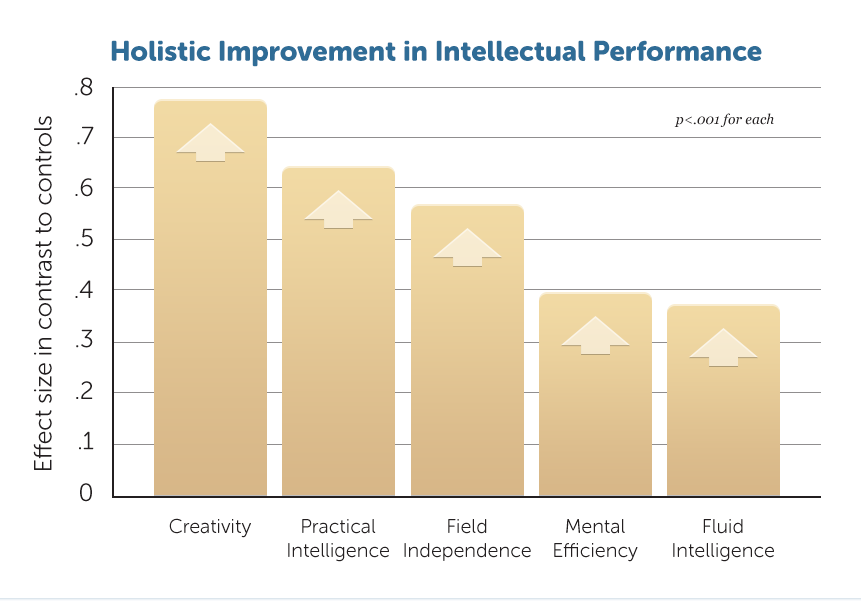 In Taiwan 362 secondary school students were randomly divided into 4 groups, a TM group and 3 control groups. The 3 control groups included: 1) a resting group, 2) a group practicing contemplation meditation, and 3) a group which received no specific attention. After 6 to 12 months the TM group showed a significant improvement in 5 different scales of intellectual capability, including two scales of intelligence, “practical intelligence” p=.00009 and “fluid intelligence” p=.001 as compared to the 3 control groups. The TM students also showed a significant decrease in stress as compared to the control group.Ref.Intelligence 29: 419–440, 2001
In Taiwan 362 secondary school students were randomly divided into 4 groups, a TM group and 3 control groups. The 3 control groups included: 1) a resting group, 2) a group practicing contemplation meditation, and 3) a group which received no specific attention. After 6 to 12 months the TM group showed a significant improvement in 5 different scales of intellectual capability, including two scales of intelligence, “practical intelligence” p=.00009 and “fluid intelligence” p=.001 as compared to the 3 control groups. The TM students also showed a significant decrease in stress as compared to the control group.Ref.Intelligence 29: 419–440, 2001
Less neurosis among industrial workers
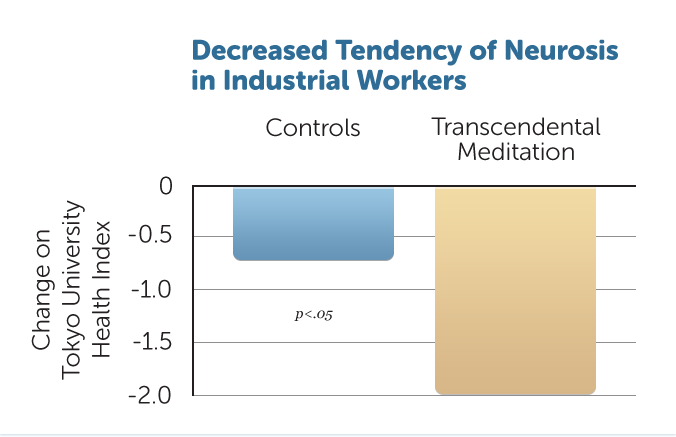 A study at Sumitomo Heandevy Industries, carried out by the Japanese National Institute of Industrial Health, found a decreased tendency of neurosis among over 400 employees that had been taught the Transcendental Meditation Programme, in comparison to controls.Ref.Japanese Journal of Industrial Health 32: 656, 1990
A study at Sumitomo Heandevy Industries, carried out by the Japanese National Institute of Industrial Health, found a decreased tendency of neurosis among over 400 employees that had been taught the Transcendental Meditation Programme, in comparison to controls.Ref.Japanese Journal of Industrial Health 32: 656, 1990
Increased Physiological Calmness in Executives and Workers
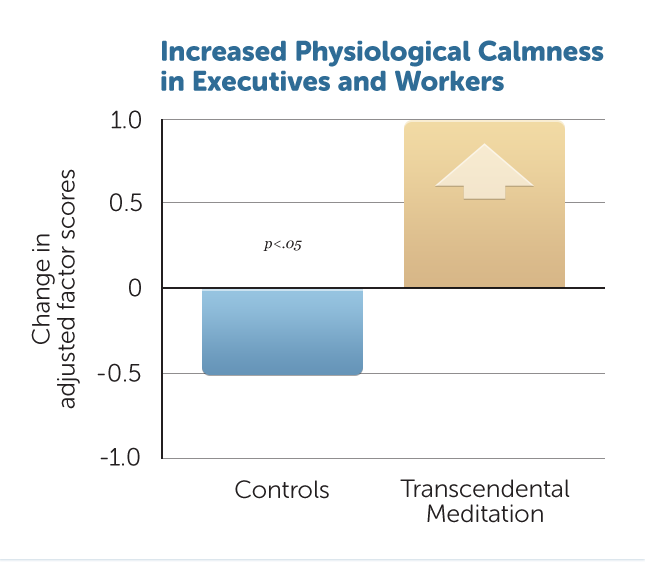 A study of executives and workers in the automotive industry found that after three months of regular practice of the Transcendental Meditation Programme, participants showed increased physiological calmness, as assessed both during rest and during task performance, in comparison to controls from the same work sites.Ref.Anxiety, Stress and Coping: An International Journal 6: 245–262, 1993
A study of executives and workers in the automotive industry found that after three months of regular practice of the Transcendental Meditation Programme, participants showed increased physiological calmness, as assessed both during rest and during task performance, in comparison to controls from the same work sites.Ref.Anxiety, Stress and Coping: An International Journal 6: 245–262, 1993
Less tensions at work
 A study among management and employees in the automotive industry found that employees, after three months of regular practice of the Transcendental Meditation Programme, had less tensions at work than controls at the same work place.Ref.Anxiety, Stress and Coping: An International Journal 6: 245–262, 1993
A study among management and employees in the automotive industry found that employees, after three months of regular practice of the Transcendental Meditation Programme, had less tensions at work than controls at the same work place.Ref.Anxiety, Stress and Coping: An International Journal 6: 245–262, 1993
Business and Industry
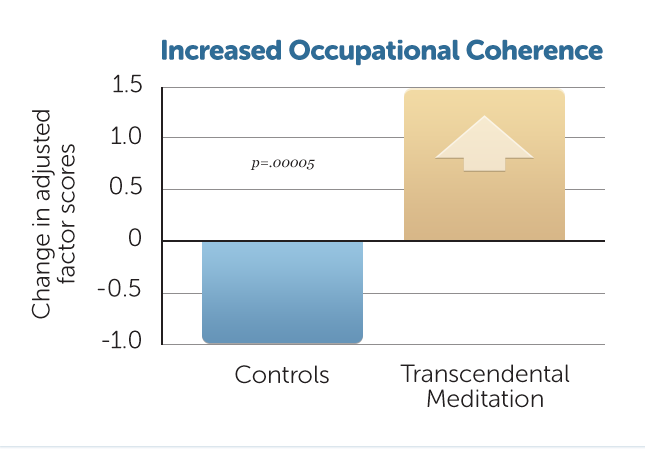 A study of executives and workers in the automotive industry found that after three months of regular practice of the Transcendental Meditation Programme, participants showed increased occupational coherence, as assessed by seven job-related measures, in comparison to controls from the same work sites.Ref.Anxiety, Stress and Coping: An International Journal 6: 245–262, 1993
A study of executives and workers in the automotive industry found that after three months of regular practice of the Transcendental Meditation Programme, participants showed increased occupational coherence, as assessed by seven job-related measures, in comparison to controls from the same work sites.Ref.Anxiety, Stress and Coping: An International Journal 6: 245–262, 1993
Improved Postgraduate Academic Performance
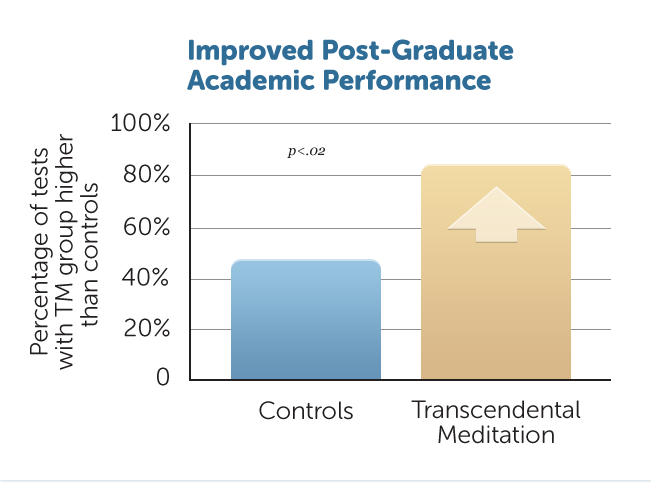 Master degree engineering students who learned the Transcendental Meditation Programme showed improved performance on their standard examinations after six months, compared with randomly assigned control students from the same academic programme.Ref.British Journal of Educational Psychology 55: 164–166, 1985
Master degree engineering students who learned the Transcendental Meditation Programme showed improved performance on their standard examinations after six months, compared with randomly assigned control students from the same academic programme.Ref.British Journal of Educational Psychology 55: 164–166, 1985
Better Results in Education
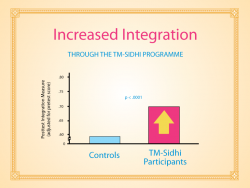 Increased Integration
Increased Integration
Students who learned the TM-Sidhi Programme were found to increase over a nine-month period in integration. Integration, which was defined as the degree of integration of the person’s system of valuations—that is, how much the person’s valuations were centered around one fundamental valuation or philosophy of life—was measured as one dimension among several in an open-ended interview, rated by independent interviewers, designed to elicit expression of experiences that the subject values in life.Ref.Modern Science and Vedic Science 1: 471–487, 1987
Reduced Behaviour Problems in School
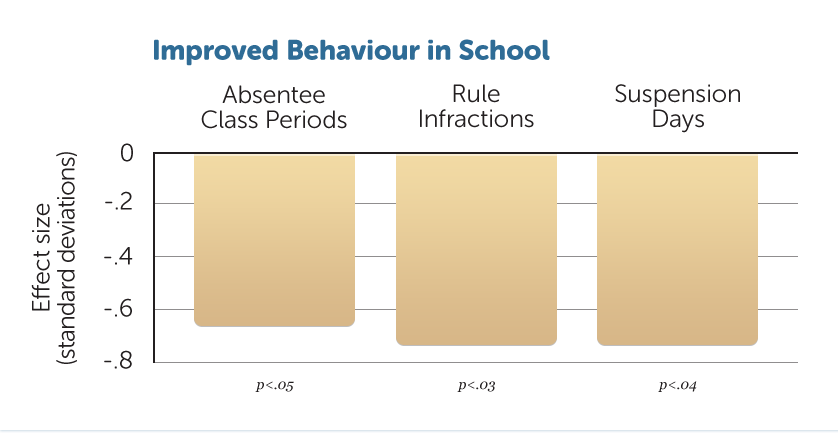 Adolescent children with high normal systolic blood pressure were randomly assigned to either learn Transcendental Meditation or participate in a health education control group. After four months, the students practicing the Transcendental Meditation Programme showed decreased absenteeism, decreased school rule infractions, and decreased suspension days. Ref.Health and Quality of Life Outcomes 1: 10, 2003
Adolescent children with high normal systolic blood pressure were randomly assigned to either learn Transcendental Meditation or participate in a health education control group. After four months, the students practicing the Transcendental Meditation Programme showed decreased absenteeism, decreased school rule infractions, and decreased suspension days. Ref.Health and Quality of Life Outcomes 1: 10, 2003
Increased energy among students
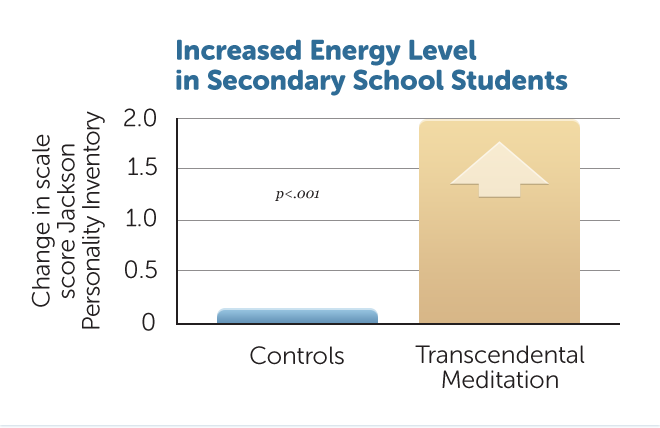 Secondary school students who learned the Transcendental Meditation Programme showed increased energy levels after 14 weeks, in contrast to control students.Ref.Dissertation Abstracts International 38(7): 3372B–3373B, 1978
Secondary school students who learned the Transcendental Meditation Programme showed increased energy levels after 14 weeks, in contrast to control students.Ref.Dissertation Abstracts International 38(7): 3372B–3373B, 1978
Prison rehabilitation
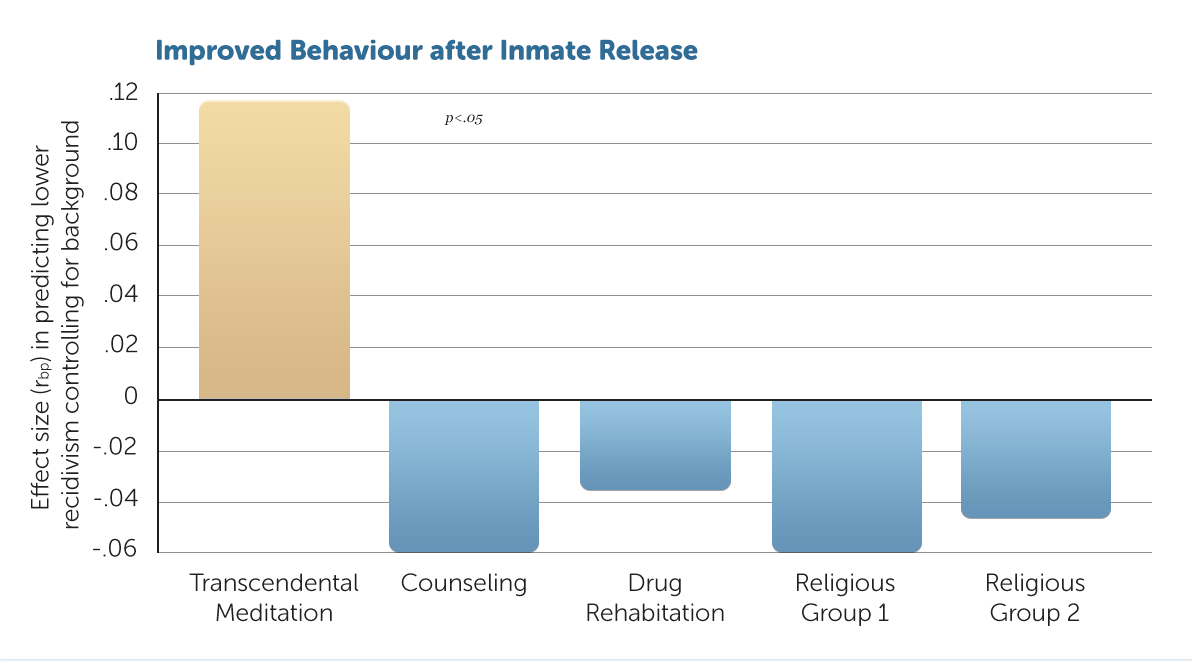 A doctoral dissertation at Harvard University found that inmates in a maximum security prison who learned the Transcendental Meditation Programme showed significantly decreased return to prison after at least 36 months, in comparison to random samples of participants of four other prison rehabilitation programmes, controlling for time of release from prison.Ref.Journal of Offender Rehabilitation 36: 161–180, 2003
A doctoral dissertation at Harvard University found that inmates in a maximum security prison who learned the Transcendental Meditation Programme showed significantly decreased return to prison after at least 36 months, in comparison to random samples of participants of four other prison rehabilitation programmes, controlling for time of release from prison.Ref.Journal of Offender Rehabilitation 36: 161–180, 2003
Prison rehabilitation
 Parolees of the California Department of Corrections who learned the Transcendental Meditation Programme while in prison showed significantly fewer new prison terms in comparison to matched controls, at one year after release and overall from six months to six years after release. In contrast, prison education, vocational training, and counseling programmes had no consistent effect.Ref.Journal of Criminal Justice 15: 211–230, 1987
Parolees of the California Department of Corrections who learned the Transcendental Meditation Programme while in prison showed significantly fewer new prison terms in comparison to matched controls, at one year after release and overall from six months to six years after release. In contrast, prison education, vocational training, and counseling programmes had no consistent effect.Ref.Journal of Criminal Justice 15: 211–230, 1987
Prison rehabilitation
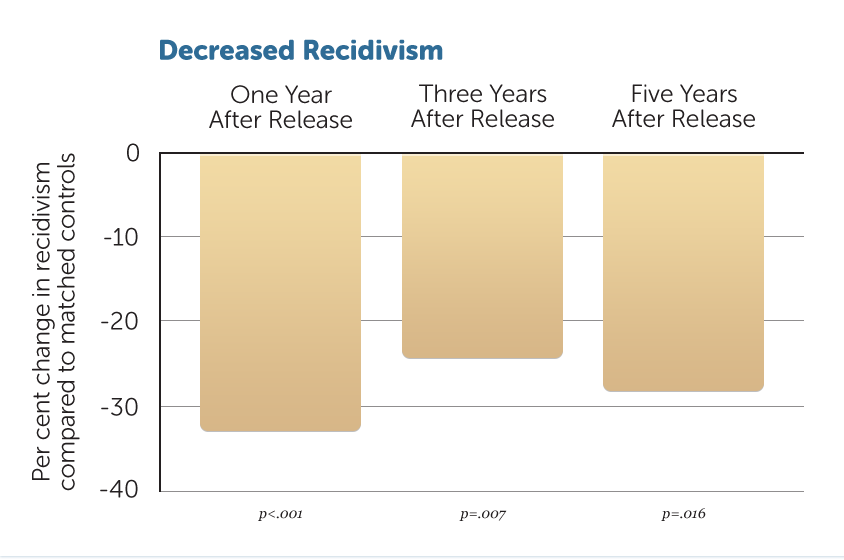 Parolees of the California Department of Corrections who learned the Transcendental Meditation Programme while in prison showed significantly decreased recidivism, combining all parole outcomes over a five-year period after release, in comparison to matched controls.Ref.Journal of Criminal Justice 15: 211–230, 1987
Parolees of the California Department of Corrections who learned the Transcendental Meditation Programme while in prison showed significantly decreased recidivism, combining all parole outcomes over a five-year period after release, in comparison to matched controls.Ref.Journal of Criminal Justice 15: 211–230, 1987

